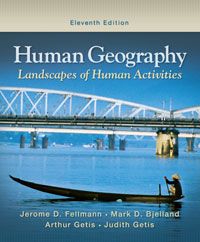 
Human Geography: Landscapes of Human Activities, 11th Edition (Fellmann)Chapter 1:
Introduction: Some Background BasicsObjectives for Chapter 1After reading and studying this chapter, you should be able to:
1. Define and explain "geography." |
 |  |  |
2. Explain the evolution of the discipline of geography from ancient times to the present. |
 |  |  |
3. Explain the differences among human, regional, and physical geography. |
 |  |  |
4. List the types of employers that hire geographers. |
 |  |  |
5. Define the word "spatial" and use it as a geographer would. |
 |  |  |
6. Contrast and provide examples of absolute and relative location, site and situation, absolute and relative direction, and absolute and relative distance. |
 |  |  |
7. Explain scale as it is conceived by geographers and discuss how it applies to maps. |
 |  |  |
8. Compare the natural and cultural landscape and describe how the attributes of places change over time. |
 |  |  |
9. Discuss the basic ideas of spatial interaction. |
 |  |  |
10. Summarize the concepts of density, dispersion, and pattern. |
 |  |  |
11. Define the term "region" and demonstrate knowledge of functional, formal, and perceptual regions. |
 |  |  |
12. Identify different ways that maps show data. |
 |  |  |
14. Summarize the importance of mental maps. |
 |  |
|





